
Preface
This is a theoretical writing how to draw exactly the landscape for fieldwork with the drawing scale which I invented for my own use in 1993, gthe thought and practiceh, gWhy and Howh. I began to write this file from 2001 December and completed in 2002 June, daily posted and updated on my homepage. it was 20 years ago!
I found the landscape painting in 1989. Since then I was working in this field almost 20 years until 2007. I needed to summarize the practice during 10 years since 1989 as one writing to publish on Internet in 2001.
There is no one who drew like me. This method is very unique and practical
for an artist. Man says it is easy and accurate to copy a photo than your
method, but it is that such a foolish man who had troublesome work in field
with his drawing scale facing to his landscape, once existed.
I had completed the whole my big homepage with the picture gallery and writings 300MB with my original image parts and the JavaScript programs in 2007. But the elaborated homepage hadnft been normally running on Chrome by some technical problem of my JavaScript program until next year 2008. I was suffering from Cataract of my right eye in 2008. My mother lost her right leg by thrombosis in 2011. I had to care poor my mother since then. I had completely had no time for ten years till 2020.
Since then the communication environment of Internet has been dramatically changed better. I solved the problem of my JavaScript program. I decided to revise my homepage for a smart phone not to throw away my 9000 hours work since 2000, and to give it the life once again.
I have been aged. It will be never again to go out to the field to paint landscape.
2022.03.04 Masaaki Sugita
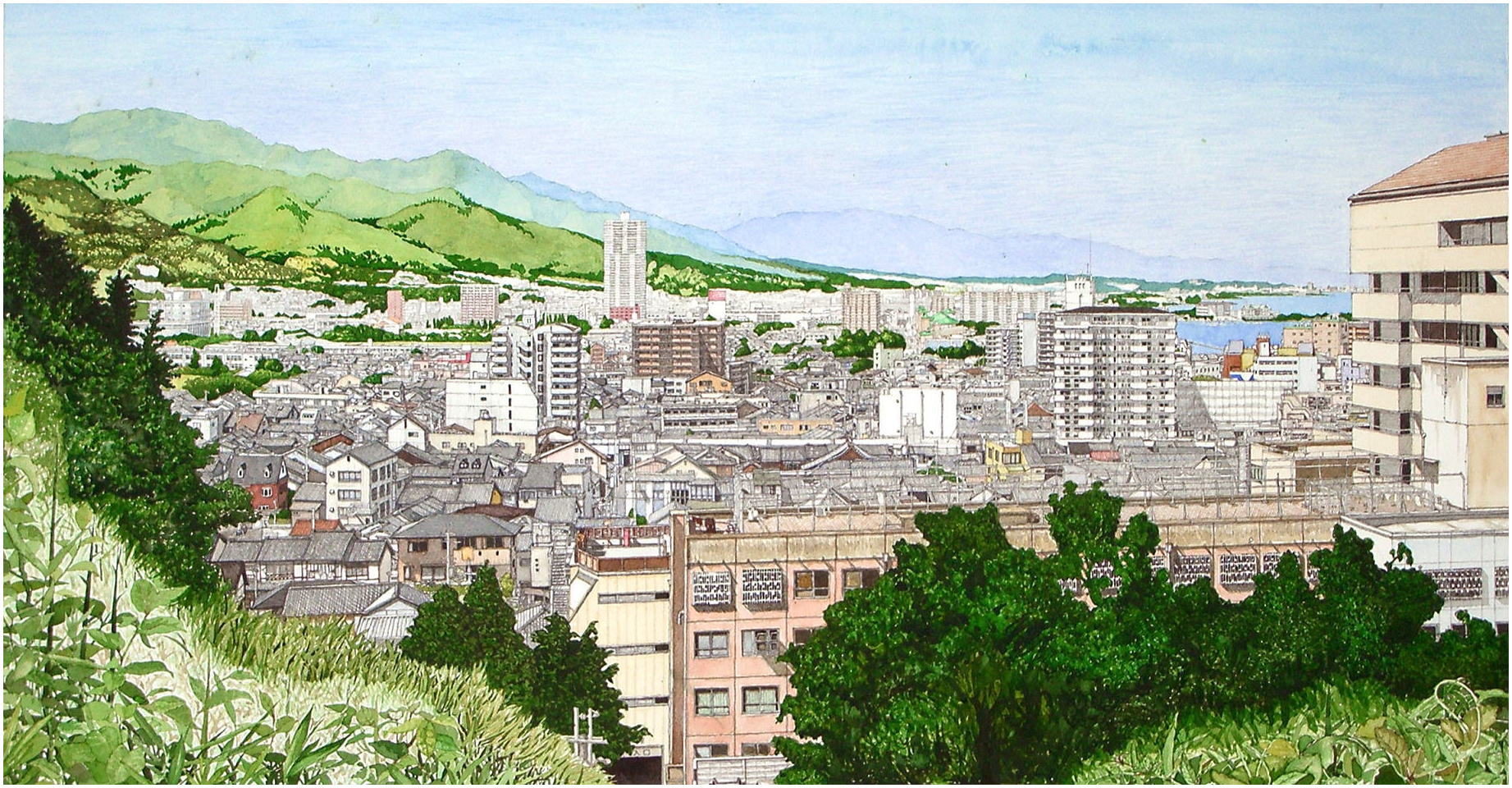
5003040 Landscapes in Otsu No. 40 / 2005.06.14 / watercolor 270 x 520mm

 ere, I explain
ere, I explain
the process of my water color paintings
and its thoughts,
how to draw it
and reasoning why I did it so.
I have been explaining my thought about my painting until 1-3, it may be
boring. If you want to know the practical method, then you can skip its.
Vol. 1 CONTENTS
1. Why am I going to draw exactly?
1-1. What is the individuality of a realism painting?
1-1-1.' Paint as you feel it' means usually 'Don't mind whether your painting
1-1-2. A painter is usually painting not knowing his What?, How?, Why?
1-1-3. we won't say that we painted the individual picture, only we painted
1-1-4. We can neither paint the view as it is, nor arrived at the only one
1-1-5. Examples about the Objective and the Subjective, the result is various
1-2. Where it is what I understand as beauty?
1-2-1. I didn't feel that house like this, but saw that house like this. But,
1-2-2. We can stress on the particular object in the view, and the stressed
1-2-3. We apt to project our feeling and emotion to our view, so that Being
1-3. What composition do I love for landscape?
2. About the sheet size
2-1. three reasons to use that sheet size; 370x550mm.
3. About materials

3-1. Why do I use a 0.3mm mechanical pencil and pen?
3-2. How should we hold a pencil for a exact drawing?
4. About the method of landscape drawing
4-1. What do we need for the exact drawing?
4-2. Two drawing methods
4-2-01-02 About the setting of the paper board and an easel
4-3. the method by my drawing scale
4-3-01. About my drawing scale
4-3-02. The characteristics of my drawing scale
4-3-03-03. When the eye positon happen to change from at a to a'
4-3-04. About another instrument for drawing
4-3-05. about the fault of the measurement by spherical coordinate
4-3-06. What kind of figure am I going to l draw and get on a picture plain?
4-3-07. a photo image and the picture by my drawing scale, what's
4-3-08. Why do we feel a straight line as straight
4-3-09. Basic rule about a vertical and a horizontal line and a straight line
4-3-10. the important conclusions about the characteristics of my drawing

1
 hy am I going to draw exactly?
hy am I going to draw exactly?
I used to draw each details as precisely as I can.
I want to paint each object as it is, yes as it is.
And sometimes on a fine day, blue sky and white clouds and lucid air and
light, I feel sometimes I could depict all what I was seeing in my view
spreading there in front of my position on a hill below!
I try it, still, I can't.
It is really still a painting by lines and color.
How far and different it is!, between the sight and the paint!
It is simple motivation but really I have it and think it fun.
Of course there is no obligation to do so for me. Someone says it's enough
to take a photo and it's much precise. And even other ask me why I need
to paint precisely?
Why do I need?
I don't know but certainly I want.
Do I know the world of daily life? that I am seeing. I want to know what
it is. I say it's a house, when I see a house. I say it's grass. I say
it's tree.
But I don't know completely why its are there.
But those are there effected or linked with unknown cause, maybe.
Certainly, I know its by the name. But really what is it?
I say it's a tree. The tree was constituted by a trunk, limbs, branches,
twigs and leaves. The leaf was constituted by a stem, midribs, veins and
blade. The blade was constituded by cells. The cell was by etc.
It is infinitive asking.
And there I am seeing are infinitive number of infinitive one unit.
And also I ask, "why is it there?"
I don't know.
I don't know about its history,
even though its are completely common and usual things,
and even I hate them for that plentifulness.
What I am seeing is the collection of the infinitives.
But I can see it and understand it, indeed it is infinitive.
Why?
It is marvallous.

1-1
 hat is the individuality of a realism painting
1-1-1.' Paint as you feel it' means usually 'Don't mind whether your painting
exactly reflects your feeling or not, and the resemblance to the view,
and usually the saying is an excuse.
hat is the individuality of a realism painting
1-1-1.' Paint as you feel it' means usually 'Don't mind whether your painting
exactly reflects your feeling or not, and the resemblance to the view,
and usually the saying is an excuse.
I have been hearing or being taught in childhood,
"Paint as you feel it!"
If I felt the impressive blue of the sky, I might paint out by blue over a sheet by that teaching, with directly pressed out blue painting material from the tube.
But it is just the word itself, the sky was blue, so the action immediately
connected to the blue painting material.
So that atitude apt to be the lack of the diversity of expression or contents, means abstract.
But, if we were satisfied with its result, that expression or that done might be understood as the expression as what we felt.
Namely, what we painted being as what we felt, might be also the judgement
by the relation between painting and that result.
So it is only that if the result was good, we wouldn't care about whether
the result correctly reflects our feeling or not.
Certainly, the important talent as a painter is the ability of the judgement about that result.
He couldn't be a painter, if he judged his portrait only by the point of
view, whether the appearance was resemble or not, even though his work
was beautiful as an abstract painting, this is remarkable for the valuation
after morden art, indeed.
Everyone know that, perhaps. Actually, "Paint as you feel it!"
means no more than "Paint freely from the objects and don't mind the
result!".
But the word "Paint as you feel it!" is really difficult thing
for a child, even a man.
Because what we feel is the thoughts, the logics and to paint is the expression
by visual image
We usally express the feeling by words.

1-1-2
 painter is usually painting not knowing his What?, How?, Why? to his painting.
painter is usually painting not knowing his What?, How?, Why? to his painting.
Certainly, I felt often I want to paint as I feel it. And I tried it.
But the result was bad. I couldn't be contented with it.
Why?
Because, it was only the state of mind, that I had only a voilition to
paint something.
But, at the same time, it was only that I didn't know exactly that something,
what I paint or
how I paint it.
If we are going to do it by the visual image, then we need any interpretation
from the word to the visual image, that are very different nature from
each other.
The interpretation is quite difficult.
And if we could do it successfully, that would be deserved as the name
of an invention or an achievement.
Then, Why do they say it as "Paint as you feel it!"?
I think it almost as an excuse for one reason.
We probably do say it like "We painted as we felt it" whether
the result is good or bad, we want to say that we did it with an intention,
not without it.
And it might mean that we have sucessfully done it as we felt it.
Especially, a professional painter or a specialist might need that excuse.
Or he might have the method or logics of the interpretation and could explain
it.
We can't judge his painting whether his painting is the same thing just
as what he felt or not, because he shows only that result. So we at least
understand he
said that he did it correctly. But there is not the certification or the evidence.
Probably, every one had had that feeling once, who had felt once to paint
something. So, it is unreasonable advice that ordering 'Paint as you felt
it!' to those who don't know that
What or
How.
Except a child's case, a child's painting is a like sport and an instinct
to be grwon up, if he like it to do. So he needs no reason.
If a painter could understand clearly his
What?,
How?, and
Why?, it is that he has got his
Subject for a painter.
It is really long way to find it for us and difficult.
When we find its, then we can advance steadily and far distance for a painter.
And it is that I am now clearly understand my Subject of my works.
A painter who teach us 'Paint as you felt it!' is understanding that the
most important thing for paint is to express what he felt, is just
his stance on a painting, is only one solution, is never only truce but one judgement,
and characteristic opinion for modern painter.
We don't need to obey his doctrine.
And I think the most of them are only painting not knowing his
What?,
How?,
Why?, are lacking the talent as a painter, modern painter, if they say themselves as specialists or professional painters.
But, we, probably themselves don't usually aware of the lack of talent,
for , as I mentioned, we can't know the relation between what he felt and
what he expressed, and the evidence, whether he has sucessfully done it
or not, as he says it with a confident air as he has sucessfully done it.
Especially, after modern art, we apt to give them the excuse, or the trick.
Still, as I am fair to that judgement, if the result, his painting was
excellent one, I willingly estimate he was a really a speciallist or professional,
or a genius without his
What?,
How?,
Why?.
Why do I say such a thing?

1-1-3
 e won't say that we painted the individual picture, only we painted
a different picture.
e won't say that we painted the individual picture, only we painted
a different picture.
There are many painters and critics who are saying just on his lips that
'to paint as it is' is nothing improtant and not art at all.
Then I ask them, 'What is important?'
Someone says the important thing is 'individuality' and other says it is
'Concept'
If it was the individuality to paint only indefferently from the view,
every one can be a unique painter who paints only different picture from
the view and the other's.
But, usually we always paint different picture, except to copy intentionally the other's, still imperfect except being a copy machine, is the usual scene, nothing unusual.
And then he has a common character on the contrary to his doctorin, that
is 'to be different from others', is being not different from other morden
painter at this point of logics.
So it is that he is saying about a way of particular expression.
But, Do we say it as the individuality only painting differently?
Probably, we don't.
At the same time, We are always painting the different picture, even if
we painted
earnestly the same view
by hands and eyes.
Why?
For, we are an individual human, not a camera, not a copy machine.
Still, we don't know whether it is an individual painting or not.
And we won't say that we painted the individual picture, only we painted
a different picture.
Why?
We don't think it individual painting only at random. We never say that
'to connect at random' is 'Being individual', but the reasonable combination
and choice, is one of invention, that means 'Being different ', by the
nature, from others, is 'Being individual'.
Can we distiguish A random from B random?
No!, we probably only categorize them for one groupe by the same nature,
Abstractness, 'Being random'.
By the same reason, we probably categorize the Jackson, Pollock's drippings
for the same paintings.
Certainly, 'A' his dripping is different from 'B', but we probably say
its by the same naming, the drippings.
Gogh's paintings and Pollock's paintings are categorized for two different
groupes, Impressionism paintings and Abstract paintings, are, definitely,
characteristic each other.
Monet's and Gogh's are categorized for same group, impressionism. But those
are also characteristic each other.
And Jan Van Eyck and Roger Van der Wyden are also categorized for same
group, Early Netherlandish Paintings, Realism Christian Image, are also
charactereistic each other.
So we shouldn't think it too much that it is only the certification of 'Being individual' to be belong to the different categories, and need not.
Even we could have painted realistically the same object, we can be possibly quite an 'Being individual', like the realation between an Van Eyck and Roger Van Der Wyden.
Why?

1-1-4
 e can neither paint the view as it is, nor arrived at the only
one expression, the Objective itself, if we tried to do it.
e can neither paint the view as it is, nor arrived at the only
one expression, the Objective itself, if we tried to do it.
A realism painting, to reproduce the real view by painting is thought as
an Intermediate between the Being Objective and the Being Subjective, not
the Objective only, not the Subjective only.
If it was the Objective only, it was infinitively getting nearer to an
image reflected on eye retina like a photo at the same position and conditions,
and if it was the Subjective, then it was infinitively getting nearer to
an Abstract painting.
So our paintings will be standing at the position somewhere between the
Objective only and the Subjective only, by the condition, where we stress
mainly on, either the Objective or the Subjective.
And the result will be various between the Objective and the Subjective.
Where we stress on, is, certainly one of our tastes, one of our individualities,
but it is neither only one, nor all.
And we can't approach infinitively nearer to the Objective, as far as we
are human being and painting by our eyes and hands, even though we tried
to reproduce the Objective as it was, by the individual error, sense, tastes,
feelings and thoughts, means what I say as the individuality of the realism
painting.
The negative opinions about the realism are supposed to be the cause of
the misunderstanding, that we can be easily, infinitively getting nearer
to the same and only one expression, the Objective itself without a copy
machine and a camera.
We can't do that at all.
Who can do that? , and who could do that?

1-1-5
 xamples about the Objective and the Subjective, the result is various
for the condition, where we stress on between them.
xamples about the Objective and the Subjective, the result is various
for the condition, where we stress on between them.
Even if it is the precisely expressed realism landscape painting, we will
find there the cobination of the Objective expressed by the Subjective
and the Subjective regulated by the Objective, that is art, excellently
individual.
The Objective expressed, if it could be, by the Subjective without any
rule, the Objective, is the Subjective only, is only a painting at random,
might not be art.
To be expressed, we might say it by another words, to be able to be exchanged
by something else.
Then what is the something else? That something else must has common nature, intermediate to the
something.
Probably, we don't say that 'to indifferently connect A and B' means 'to
express A by B'.
Then there must be a particular rule, that is the Objective, at the same time, to choice a particular rule is the Subjective.
For example;
If you paint the sky part of your picture with darker blue color to stress on the impressive blue sky, then your painting will branch into two different direction by your stance.
One branch is a realism landscape painting:
If you give priority to express the impresssive blue sky on the point of
view, the resemblance with the view
on your eyesight, then you do it comparing your picture with the view, by your sensation
through your eyes, how much you should darken the sky with blue, then your
picture will have the similar nature as a Constable's.
The other is a impressionism painting:
If you give priority to express the impressive blue sky on the point of
view, the harmony and the unity and the balance
on your picture, then you can give your sky
the very dark Ultramarine Blue like a Gogh's, 'the church at Auvers', if you can keep the harmony and the unity and the balance of your painting.
In the former case,
the expression of the impressive blue sky will be setle within the limitation
of the resemblance with the view, but as far as we judge it by our sensation,
it's will fluctuate within particular range of value. And the judgement
and the result naturally reflect our taste and the limitation, or imperfectness
of our ability of painting. That means our Individuality.
In the later case,
the expression of the impressive blue sky will be able to be any expression
remaining within a minimum condition for a landscape painting, but the
expression began to step out to the direction for the independancy of a
painting, and it is at the moment that the Subjective is recognized also
to be able to choosed as an object.
The same object, target of your picture, to express the impressive blue
sky, the Being Subjective will be settled on different result by the condition,
whether you stress on, either the resemblance regulated by the view, that
is rather the Objective, or the harmony and the unity and the balance on
your picture regulated by your feeling, that is rather the Subjective.
The both cases are still holding the common nature, rough resemble shape and color etc, to the view as far as remaining within a landscape painting and the both case have never, at least, nothing the Subjective.
The difference is that 'Where do you stress on either on your eyesight,
or on your picture?'.

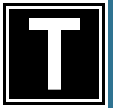 he extent branching
he extent branching;
If you give priority to express the impression itself, still existing within
an impressive blue sky,
on your brain, namely, the Subjective being independent from the object, the view, the
then you can get rid of the limitation being within a landscape painting.
Then it might be a abstract painting, if it remained within a painting.
Further extention;
If you give priority to
no other than the expression itself, it will be a mere concept remaining, because, here the target is neither
the individual impression, like the impressive blue, nor the individual
Being Subjective, but anytthing, in general meaning, the Being Subjective,
then you can choose your object freely from anything you want, whether
it is the Objective, or not , the really Existing, or not, the Rational
or not, etc.
By the way, historical point of view, we have been choosing a painting
to express the Being Spacific, in where God and mortals have been playing
their story until the impressionism. From the impressionism, we have been
getting rid of the elements one by one, that are holding the expression
within the real object, stiputed the expression for the real object.
As our object of the expression being purified, our expression is also
being simplified.
Now the contemporary atists have had only the Pure or Bare Concept to be
expressed and the simple expression, if we can say it an expression.
We don't know whether our object is plain or not, cubic or not, material
or not, for our object hasn't any stipulation except being a concept itself,
then we don't need to choose a painting as the medium, we can choose a
not material, performance, etc.


ut, whatever the contemporary atists choose for media, generally their
expression haven't enough contents. For, as I mentioned, their object have
been purified.
For example;
even though they choosed a video for a medium, their video is no more than a moving picture,
for as soon as they contain any meanings, anything beyond the bare concept into them, then its will be directly connected with particular reality,
then its will stop being art, concept, and will have been rather a
movie art or documentary film.
Likewise, we can even use sound, but it will be mere sounds itselves, for
as soon as it had a rthythm, or harmony, then it will be a
musical art. We will be able to say to the performance as well.
However the appearance of the contemporary art looks like full of the liberty
and freedom about its choice for its object, expression and media, the
simplified object can bear no more than a simple expression, as it were
saying like this, 'You can choose freely anything you want, but only one'.
This is the appearance of our CONTEMPORARY ART.
These process, art history after mordan art to contemporary art, if there
was something we can say it as a history, is just purifying our object
for an art.
As far as we are trying to purify our object of art, we will have to finally
arrive at that concept.
The procession is like to pinpoint the precise location of the Being Artistic, for example, the beauty. We are stripping off and abandoning one by one the environment srounding that pinpoint until the bare concept coming out.
But here the absolute limitation is coming out.
We can't step into the concept by visual expression any more.
We cannot help recognizing it at last that our visual expression is never
suitable medium to the coming out bare concept, but it is logics.


amely, our expression is too ambious to that concept
At the same time, as far as we are trying to insist obstinately that we
could express that concept, then we have to make our expression much more
ambiguous not to be revealed the contradiction between the expression and
the concept. Being the expression ambiguous, then we possibly connect it
with the concept at random.
For example;
we can't understand its without explaining, 'What is it?', the concept,
virtue, chastity, etc. by the personification in old time. And we doubt
its meaning to express its by such personifications, after we had been
explained. It is that we are trying to express the bare concept by the
person wearing very rich and decorative clothing.
another example;
about Marcel Duchamp's ready made objet, the toilete bowl
the toilete bowl is completely a practical thing as every one understand,
but he put it as the object of his art, means he connect it with his expression,
purified concept, expression itself. If he could connect them, then its
possiblly be equal each other, balanced each other. As on one side of the
balance is his purified concept, then on the other side be purified the
toilete bowl, purified the toilete bowl?, ?, it has to be no other than
a toilete bowl, stripped off all its concrete qualities, there possible
remains a bare concept itself for the object of his art, expression itself,
we don't know what it is, but it isn't, at least, a toilete bowl.
Those two examples have the same appearance, except we have had an excuse,
by another words, we have objectified even the expression itself.
As I mentioned, these are possible, as far as we stress on the expression itself, neither
this expression,
nor
that expression, in general meaning, but the expression itself, means everything is possiblly expressed, at the same time, possiblly expressing nothing.
And those having nothing quality, then its are single-use only, disposable
art category. We can't neither recycle it, nor make its much more excellent,
like a landscape painting that has much contents and qualities, for its
has no quailty.
I may say that those progressive procession of the contemporary art is
caused by trying to pinpoint the lacation of the Being Artistic Element,
like beauty. They are misunderstanding as if the elements can exist only
by itselves not considering that environments, our experiences, our psyhcological
effects.
It is the procession of the Emperor's New Clothes, indeed.

1-2
 here it is what I understand as beauty?
here it is what I understand as beauty?
Everyone probably has experience being delightful seeing a view of the
countryside, mountains, lakes, or the ocean and the sky. And he felt it
probably beautiful.
Where it is that beauty?
On a particular color? or particular line, or shape, or particular combination
of those?
Or on the whole view?
Or on the image in our brain?
Probably, the beauty is the estimation about the relation between the view
and us, our position, wealth, condition, and situation. Probably, We can't
explain beauty without that environments.
I don't judge it, where is it the beauty?, when I was seeing and felt the
view was beautiful.
Probably, the beauty or what I felt beautiful is
there, in the whole view that I am seeing. Because I can't feel it, if I didn't see it.
So I used to depict every deatails as I am seeing it like to scoop all the water of lake, of course if I could, to catch the fish, the name of Beauty in the water.
Then we could catch the Beauty without asking 'Where is the Beauty?'
And I don't think it as a trifle thing to depict every details as it are.
For I think it marvous the immense varielty of the world, as I said.
And the beauty or the causing to feel the beauty is probably
there also in my painting as well as in the real view, if I could reproduce
it as it was or the probable appearance.

1-2-1
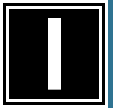 didn't feel that house like this, but saw that house like this.
But, that is still the judgement by our sensation through our eyes means,
as a result, that I paint it as I felt it, even I painted it faithfully
to the view.
didn't feel that house like this, but saw that house like this.
But, that is still the judgement by our sensation through our eyes means,
as a result, that I paint it as I felt it, even I painted it faithfully
to the view.
'Paint as you feel it!'
As a result, I did paint it as I felt it.
As I say it, "as I felt it" much more exactly, it is that
"As I felt it (beautiful), so I paint it, and I paint it as I saw it."
And I say it
"Paint as you felt it!" much more precisely, that means "Paint freely from the objects by your expression,
style as you like it, and don't mention that result for the resemblance with your eyesight".
On the contrary, as I mentioned I think that beauty is in the whole view,
that resemblance as the visual, and I want to express that.
Then, why can I express that beauty or the pleasant feeling when I am seeing
the view without reproduce that resemblace?
And it is my style to paint faithful for my eyesight
I didn't feel that house like this, or that sky like this, or that color
like this, or that line like this etc, but
saw that house like this, or that sky like this, or that color like this, or that line like this etc.

1-2-2
 e can stress on the particular object in the view, and the stressed
painting can be much more natural to our sensation, for we have some particular
tendancies about the judgement of eyesight, and also we often project our
feelings and emotions to the view, and recall that feelings and emotions
in our experience by the view as well.
e can stress on the particular object in the view, and the stressed
painting can be much more natural to our sensation, for we have some particular
tendancies about the judgement of eyesight, and also we often project our
feelings and emotions to the view, and recall that feelings and emotions
in our experience by the view as well.
I could say it that I
felt A house was much brighter than B.
And our human nature has some particular tendancies about the judgement
of eyesight.
We usually feel the size of Sun or Moon on the Horizon much more bigger
than it's real, proportional size to the other objects, relative size.
We are sometimes disappointed by the photo shot the sun, 'Oh!, it's too
small!'
And I will mention after my typotheisis about the human understaning of
the eyesight.
So there is possiblly the reason to stress on the particular object.
And that stressed expression will be felt much more natural expression
to our nature than the pure objective, or mechanical sight.
So we are 'Being individual' by our nature, human error, as far as we paint by our eyes and hands, without a camera and a copy machine.
But the stress is the stress in the relation to the others in the whole
view.
How much do we stress will be rationally determined for particular value,
as far as we do it by our sense comparing the real view with our paintings.
And that value will be fluctuated within the particular order, particular
value by individual sense.
As a result, that can be also 'Bing individual', however the appearance won't be completely different from other paintings.

1-2-3
 e apt to project our feeling and emotion to our view, so that Being
Subjective can be also the object of our painting. But those are psychological
problems. And I think it nonsense to guess the Being Subjective has independently
particular expression.
e apt to project our feeling and emotion to our view, so that Being
Subjective can be also the object of our painting. But those are psychological
problems. And I think it nonsense to guess the Being Subjective has independently
particular expression.
And there is another question, that is the Subjective, by another sense,
can be also our object.
For example,
certainly, we can feel the pleasant air for the landscape on fine day,
not cool, not hot.
And particular scene, fine day, transparent air, very good condition of
temperature will accompany particular pleasant feelings.
On the contrary, when it was raining and cold winds blowing, dim light,
we probably felt particular dreary feelings.
That means we have also the tendancy to project our particular feelings
and emotions to the view, on the contrary, particular view is expected
to make us felt or recall particular feelings and emotions in our experiences.
I guess that some painter probably tries to express that feelings and emotions,
not categorized as the visual objects, and is thinking it can be
independently express by the paintings.
I think it will be nosense to insist that 'A shape' express unconditionally
'saddness', 'B color' express unconditionally 'anger'.
But, we probably felt particular feelings and emotions on the particular
combination of the visual objects in our experience.
Those are the memories adhered on our experiences and the psychological
problems.


e may sucessfully reproduce that feelings and emotions by preparing that envoirnments, even though it were constituted by only the visual images for one sansation, eyesight.
So this time, I ask where is the feelings and emotions? on particular shape,
or particular color, or on those combination?
I don't ask such a question.
If I want to reproduce the pleasant air of landscape, then I try to reproduce
precisely the whole view.
My answer is the same thing as for the question as the case, where it is
the beauty.
There were, or still are, I don't know, the Japanese painters who insisted
on
the remarkable thought, really remarkable, or silly thought, that a realism is not to reproduce the real view. Then, What is the realism?
Ridiculous!
They can say it, at least, if they can reproduce the real view as it is.
Or, if they can paint like Gogh.
Generally speaking, those are really nothing but the painters who can't
paint realistically. Those are just boasting to the people not knowing
well, or not having enough knowlege, or interesting about art by the unreasonable
Zen Questioning like.

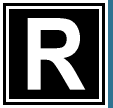
eally, those are the best examples of the indifference between the saying
and the behaving, that are connected at random.
So, this time I have to ask to them, 'Where is it the realism?'
'Is it in a particular shape, or a particular color, or a particular object?'
Those three questions about the beauty, the feelings and emotions, and
the realism are the same things.
As far as their paintings can speak nothing and can't prevail over us,
those are not the art, but the answering the thought, or the problems of
the psychological recognition by the paintings.
If it can be the art, it may be the abstract expression as the one of posssibility.
But, then it has to be visually and immediately and intuitively, without
no explaining by words , the recoginzable beauty, or something value for
Being art.
Then, we can examine about one of the elements, 'what does make us the
abstract expression understood that thought or problems?'
But the reversed order of question is invalid.
We can never say like this ' "A" beauty is that shape!' , of
course we can only say it, but it 's quite meaningless, probably.
For, those question are the relations between the art and the thought,
the visual and the logos.


hat might be
defined by the logos is the simple meaning, not the double, or multiple meanings
(except literature's expression), but what might be
expressed by the visual element can contain the complex meanings, much more precisely
say it, the many informations.
So there are possibilities, interpretations and we
can suggest there some interpretation.
But we can never say that the interpretation is truce, but possible.
They are merely insisting on their silly interpretations, not considering
the human nature and tendancies about eyesight and the pyschological problems
about our experiences.
Where is it the beauty?
Where are the feelings and emotions?
Where is it the realism?
I think it somewhere in the view, or adhering on the view, or on our natural tendancies about eyesight.
And I think it can operate the function making us feel the beauty, the
feelings and emotions, and the realism only by the whole view, and we can't
abstract that function as a sigle element from the view.
As we abstracted it, then it wasn't a landscape painting but a abstract painting.
Where? Where? Where?
I am not a miner, but a minor painter, still I don't bore the view, but
enjoy painting the view.
So I paint the view faithfuly for my eyesight, for I want simply to express
the view as it is.
As a result, the beauty, the feelings and emotions, and realism will be also on my painting, if I could do it well.
And those who think it not on the view but really on their painting or their painting activity, don't mention about the exactness of the reproduction.
So the view is just a chance for them to begin to paint his picture and
to reveal the beauty being in his ego, himself.
And then logically they might do it for his beauty without the view or
any eyesight.
And that might be to open the morden art and abstract painting.
I don't need strong stylization now and the reasoning to do it like a Gogh,
however his paintings is atractive.
Indeed that is also attractive one choice as the pleasure of painting.
Of course, the realism landscape painting is neither only one painting,
nor all, I think too.
But it's not easy work.

1-3
 hat composition do I love for landscape?
hat composition do I love for landscape?
I love the view from the hill, which contain
the near view, middle and distant. These
three element are much better, if these were
connected each other by the roads or path
or river to suggest their relative position.
Because that supports supplimentaly the effect
of the perspective or space.
So I like a very crowded houses for near view that enliven the image of their daily life. There are the shops for small business and houses and the washes and people walking, talking, that I am always looking as my life of environments.
The vivid near sight naturally takes us into the painting by the sympathy of the daily life. That is the introduction.
So I use to count each the number of the roof tiles of the house on near
view to middle with a binocular(8x24) and dipict its, if the size of the
tile is much more than 1millimeter on the painting. The size of a tile,
2mm each side is enough big worth to count and depict. If it is 1mm, then
you may do it and you may not.
This is the steady and certain working for depicting the details, though it appears as the trouble some.
The arragement of the roof tiles and its order also gives the concrete image of the relative distance for the perspective in whole composition.
I can see that shape,shadow, and condition for the nearest tiles, some
of them are burned into brown or black, old-look, maybe broken, other is
still silver, very new, maybe the beam of the roof itself bend down a little
for old.
And naturally we can't recongnize that details for middle to distant view
and it is too small to draw it. So the roof tile of the houses in middle
to distant is expressed as the possible patern.


need a middle view to settle the impression or atomsphere of the city
or town in painting. And distant view has the role to support to settle
the idea the expansion of the city.
I think these three view need to linked with roads or paths or rivers to
make an idea of the extension to the deepth.
So we can naturally move our eye from near view to distant along the roads or paths or river on the landscape painting, like walking around the town.
One example
I can offer you Schongauer's print for an example, "The carrying of
the Cross" copper engraving, Musee d'Underlinden, Colmar.
The near sight is constituded by the proccesion and crowds around Christ
carrying the big Cross. The procession is turning to the depth on the left
hand coner of the print.
You can see the sight of the soldier's back on the horse back just turning
to the right direction. And the procession is reducing and fading away
along the road to the mountain in the middle view on the left upper side.
The middle view is emphasized by the blue sky and seperated by the clouds from distant view. We can recognize easily the difference by that between the middle view and distant.
And you can see the distant view on the right upper side behind the soldiers
on the horse back in the near view. The distant view is depicted only by
the contuor lines. Very simple!, but strong and clever, how clevr expression
it is! and reasonable expression, because we know a view is generally fading
away for its distance, we can see the atomsphere and space.
The scene is constituded by three parts, near view, middle, distant, that are recongized by its different degree of the contrast,
and that are linked with the road along the mountains and the procession, that makes us felt the depth of the scene.
He is ginus draftman.
I can understand seeing Schongauer's prints why Durer himself also genius
wanted to learn by him.
What I love for the compostion of a landscape, is that makes us understood the whole view of the city or twon and its characteristics.
I don't like the compostion like a photo that I often see on magazines by amatures, that is cutted by telephotolens for a picturesque compostion,
that represents usuallly the unusual sight fot that view and that is the one of many details,
that we need another and supplementary many details to reconstruct the image of the whole city or town or village.
A camera can get quickly and easily an image, but I need much time for a painting,
so I need my each painting to represent independently the characteristics of the city or town or village for each scene.

2
 bout the sheet size.
bout the sheet size.
I use the sheet, 370x550mm for my watercolor and drawing. That is a half size of the sheet of
Aquarrel Arches 560x760mm, 300g/m2.
It was just an accident to begin to use it. I began to use it perhaps from
1987.
But now it has three reasons for me to use that size.
2-1. three reasons to use that sheet size; 370x550mm.
First, it is reasonable size by my experience
using in field to draw exactly.
You can get the visual field, the angle of 50 degree by that sheet size, when you set your sheet within your reach on about 600mm distant from your eye position.
To draw exactly, you need simultaneously compare your drawing and its object,
the sight, like them putting side by side, in fixing your head postion.
Then the visual field that you have to watch is at least double of 50 degree,
i.e. 100 degree.
And one eye has the visual field about 150 to 160 degree and its central visual field about 30 degree for clear vison.
If you fix your eye, then you get only the clear visual field, the angle
of 60 degree for two eyes. So it's much easier to compare them for the
smaller sheet size.
If you had a much bigger sheet, then you had to move busily your eyes left
to right and then right to left, even much much bigger, then turn even
your head to compare or observe the drawing and the sight by turns.
You won't be able to get the exact drawing by that.
Can you remember exactly their details and its precise size? No!, You can't.
Then you need to watch them simultaneously and juxtaposingly.
Any way, I was drawing by free hand without my drawing scale for Landscape
in Kyoto before 1992. So it was important to fix and not to change the
head position. But now, I use my drawing scale, so I don't need to do so
for a exact landscape drawing.
My drawing scale is simple but enough practical instrument, and that needs
almost not to fix head postion except relative position between near sight
and middle to distant sight.
Why? You see it on the following explane, if you can understand very elmentary
mathematics. I can be proud of my drawing scale on this point, being practical.
Secondly, that size is enough big for drawing
I can draw enough details on that sheet size and enjoy enough time especially
for landscpe watercolor in field.
For example, Canaletto's elaborate drawing, London: the Thames, looling
towards Westminster from near York Watergate, pen and brown ink with gray
wash, is 316x562mm
Another example, I could see the large exhibition of Constable in Tate
gallery Jun. 21 or 22, 1991. Then I could also see his drawing, that were
even smaller than the half of my sheet size. Those really gave me an intimate
feeling about his work, like talking with him.
I love this size. And it is rather big for drawing.
Thirdly, the problem of the cost for picture frame
I have to spend much money to the picture frames and the matts for much bigger drawing. Actually I use the frame,the size about 600x800mm. Roughly say it, the frame needs the double size of the drawing.
I found out it when I held my first exhibition
1988. Since 1988, I didn't change that size,
370x550mm, with a few exception. I was drawing
on the double size before 1987.

3
 bout materials.
bout materials.
I use a 0.3mm mechanical pencil and pens. I use its for depicting contour line, and 0.3mm HB for rough draft,
and pens and watercolor for finishing the contuor lines. I like the mechanical pen for the nude drawing as well.
And I use watercolor, not ink, even for pen for the problem of fading,
though the flow of the watercolor isn't smooth as ink.
3-1. Why do I use a 0.3mm mechanical pencil
and pen?
I use it for the exact drawing. The lines by the pencil and pen are invariable for their width.
As I dipict details like explaining, so my drawing has many elments by
lines, roof tiles, window, beams, grass, tree and even the texture or tangible
surface that naturally have rhythm only by that contuor lines itselves.
So I have found sometimes that my drawing has the quality for the independent
work only by the pencil drawing without coloring by watercolor.
I don't need much more function for the lines than a contour line.
If I used the blunt, not pointed graphic pencil or brush, the lines itselves
became to have particular meaning or expression or character and lost their
exactness. I suppose its too much for my drawing.
I have seen that Mitsumasa Anno, famous Japanes graphic painter, himself explained the important role of characteristic and variable line about his drawing on TV, NHK 12ch 1995 by comparing his drawing with the another drawing traced on his drawing by pencil.
His drawing has fewer line element than mine and his line is much more
freely drawn, so that lines itself need to or may have some expression
or meaning.
I can say the contrary about my drawing.
I suppose that my line represents an abstract nature of contour line, conceputually it hasn't the width but the boundary.
I don't expect these lines expressing emotion, but explaining the object
what it is, that it is a roof tile or window flame etc. It is simple ,
indeed simple to express an object by contuor line. But I want to show
firstable what it is. And I think that the landscape is collection of what
it is.
I am collecting these elements, that are naturally gathering to build up the image, without adding any emotional expression.
Certainly, the view of crowded city itself contains many objects, many
contour lines, that sufficiently express itself.
He needed to mention about the combination between lines and the nature
of drawing. And we need to have the better choice for each subject and
condition or our taste, if we want to have succesive work for ourselves.
Of course, I know sufficiently a line itself has expression.
For example,
Sharp and definite line presents sharp edge and gives us the strong impression, that makes us felt being in near. And blunt and vague line presents gradually receding edge, that does in distant.
I can use these different nature of two line for Nude drawing in side view,
sharp line for a hi-light of nose contour and a blunt line for a shadow
of hip line.
But you need to be aware of the difference between the Landscape drawing
and Nude drawing.
The former has many objects that almost needs not the variations of lines,
latter has a few object that I can use the variations and depict the tangible
quality as well. Early netherlandish painters used a silver point for drawing.
A line by a silver point is similar to the mechanical pencil's. That means
that we need not always choice a soft, dartk, heavy line. We can choice
many materials.
3-2. How should we hold a pencil for a exact drawing?
You had better to hold a pencil like writing letters, if you want to draw
exactly.
Because that holding can stabilize the hand putting the palm on paper to
write, then it is easir to controll the point. It may be fashionable like
a painter to hold lightly like gripping a painting knife with two fingers.
It's suitable for a soft, dark pencil with heavy, expressive line and doesn't
damage the delicate texture of paper by too much pressure, but it's not
suitable for an exact drawing.
Because you need to controll the point by
whole your arm without any support. It is
difficult for everyone.
We may understand how Rogier van der Weyden
was handling a silver point, by his painting.
The painting is St. Luke Painting the Virgin
and Child 15c, Museum of Fine Arts, Boston.

4
 bout the method of landscape drawing
bout the method of landscape drawing
We need to examine how to draw exactly and can achieve nothing only to wish vaguely only the result.
4-1. What do we need for the exact drawing?
First,
you need to recognaize the object that you want to draw and its detail,
so you had better to use a binocular for the distant objects. We can't
draw the object without clearly knowing it.
Secondly,
you have to remember your position and stabilize the position and never
change it, because you need at least 60 hours to finish on the field. If
you work 6 hours a day, then you need at least 10 days until the finish.
So you had better to be sitting on chair.
Thirdly,
you have to remember your eye position by observing the relative postion
between the near object and the distant.
Forthly,you have to measure precisely the size of
objects.
Fourhly,
you have to determine the condition of lighting and remember the sun's
position or the time or the position of shadow for shadowing and coloring,
especially if you love a fine day. Because you need to have the resonable
shadowing.

4-2
 wo drawing methods
wo drawing methods
4-2-01. the method by measurement with the eye
You can't draw exactly the complicated landscape
by the measurement with the eye. But you
have to do it as the basic knowledge.
I have been painting by that measurement
for Landscape in Kyoto. It is 1989 to 1991.
The landscape is rather simple composition,
tree, cottage, houses, and river. So It was
enough by that measurement.
4-2-01-01 How is the size of the objects detemined on the drawing?

What is the size of the image?
Imagine a skyscraper, you are in the front of it!
Then you can't see the whole structure without looking up and around.
But you can do it, if you are in long distance from it.
So the size of image is the relative between your position and it. Then
you can measure the size of the building by your two fingers.
If you don't change your standing position, then the space measured by
two fingers as the equal size of the building is also relative by the fingers'
position between you and the building.
If you don't change your standing position and you could stretch your arm so as to touch the building, very long!, you had to stretch also your fingers for equal to the hight of the building.
But, if you approach your fingers to touch your eye, then you can see the
whole view in the space between two fingers.
Namely, The size of image is determined by the relative positions, object and your standing position and your fingers' position between object
and your standing position, i.e. the fingers' position is the positon of picture plane. (fig 1)
The size of image is determined like this. So you have to keep the distance
between picture plane and your eye.
If you measure and draw the image on a picture plane as the same size of object by observing and comparing juxtaposedly your drawing and the object, you will find it smaller than what you have imagined.
Why?
I guess it by the cause of pschological effect.


We have the visual field as the function of eyes more than 180 degree.
But you can't see clearly the both end of the sides. We can see only vaguley
these sides. As I said, we have the central visual field about 30 degree
for clear vision. If you look at one object very carefully, then you won't
be able to recognize the surroundings.
And I think I may guess the pschological size of image will be much more
bigger impression than the real and relative size for the whole visual
field, and it will be the same as the image cut by a telphotolens.
So when we carelessly draw an object, then
it will be usually much bigger than the relative
size. Because we may have the impressive
figure of an object, when we are going to
draw something. And our attention will be
fixed much more stronger on that object than
on the other as I mentioned above.
Of course, it's no problem. But it's difficult.
Because then we have to multiply every elements
everytime by the same ratio applied to the
first drawn element. Then we apt to mistake
the measuring and calculating. Usually, we
don't be aware of the fact that to dipict
exactly an object or exact sketch is no other
than the measuring and calculating and checking.
You haven't been aware of that, so you can't
draw exactly.
Simply saing, the field of image that you are going to draw is framed by
a square frame as same size as a sheet of papaer, like you seeing landscape
through a window. And the field is changing by your position.

4-2-01-02
 bout the setting of the paper board and an easel
bout the setting of the paper board and an easel
The important thing for exact drawing is the simultaneously and juxtaposedly
comparing your drawing and the view. So you need to use an easel, and set
the easel at right hand, if you are right-hander, and set uprighly the
sheet as if you put the window frame and the sheet side by side.
Conceptually, to see and compare simultaneously and juxtaposedly the view and the drawing is that
you are seeing the view through the window by your left eye and your drawing by your right eye. So you can't do that , if your sheet is too much bigger.
If you don't use an easel, then you need to put the paper board on your
lap. Your eyes don't be lined up vertically, so you need to turn your head
busily up and down to see the view and your drawing, then you can't compare
simultaneously and juxtaposedly the view and your drawing. You can't draw
exactly by that.
4-2-01-03 Don't draw carelessly
We can move our hands without definite order. But, for drawing, we had
better to order our hands by words like silent reading to make ourselves
recongized the shape of objects clearly.
For example,
When I draw a house, I do it like this. The width of the front is the twice
of its height, and the window height is 1/3 of the height, or when it is
a tree, then the limb's angle is 60 degree and it is straight to its first
branch, and the length is.., the two limbs and that branch shape a isoscales
triangle, etc.
For each step, we need to check it whether it is roughly the same with
the view or not.
We can use the geometrical regular elements,
line, triangle, rectangle,trapezoid, overl
and circle for lay-out.
I can apply that for natural lines too, then we need to express by or replace
with the words to depict the details, how is it? concave, or convex, or
zig-zag, or smooth curved line, etc. Its out-line can be also given by
the geometridal elements.
I think we can depict that shapes or lines no more than we could have recognized
its by the words.
4-2-01-04 We can't draw perfectly by the measurement with eye,
then we will find consequently not a few the errors of measuring as the finish is drawing nearer.
Each elements will be determined by proceeding
elements, but the errors of measuring are
also accumulateing by the proceeding errors,
following elements will become much more
uncorrect.
So you have to compromise with that results.
You have to say it, "this is a painting".
Sure! it is a painting! The uncorrectness
or the errors will be an attractive elements
for a painting.
But if you want to draw much more exactly,
then you have to devise your method. Especially,
if you want to have much more exact complicated
landscape of city, crowded houses, you will
have to spend much more time and labours
and have tries and errors.
Then I thought another way and deviced my
drawing scale.

4-3
 he method by my drawing scale
4-3-01. About my drawing scale
he method by my drawing scale
4-3-01. About my drawing scale

This is very simple tool, but much more practical for a painter than any
other devices for perspective, like what Durer had mentioned about or instruments
has links or prism by inventors perhaps 18c.
I designed and made it in Sep. 1993 for my
own use. I'm using it now. My drawing scale
is used with a dividers for measuring.
I invented it by a very simple reason, that
it is measurable what I am seeing and to
measre is firster and easier and exact.
I remember three things, one is the words by Galileo Galilei "measure what you can, be measurable what you can't".
The words written on a boad were hang on the wall of the Experiment Center of OMRON, Japanese company that I was working. It was 1981.
Second is Japanes TV program about morden painters' histories of Ecole de Paris perhaps in 1984, 8ch, a commical drama. Henri, Reassou by Japanese actor Zaitsu was very funny.
The drama said that when Reassou paints a portrait, then he measured the model by scale.
Third is also TV program, documentary film
about famous contemporary Spanish realism
painter, perhaps Antonio Lopes by Spain Broad
Casting, I forgot that date. I remember clearly
his sketching at a street in Madrido, he
was measuring something putting a easel like
a gun on his shoulder and by two pencils
like handling a dividers.
Coming to Osaka, I was seeking the way to draw much more exactly and quickly
the landscape of city, crowed houses and buildings, that was 1992. I remember
its, so I thought I measure it!. I just did its, by the very simple reason.

4-3-02
 he characteristics of my drawing scale
4-3-02-01. My drawing scale keeps the distance between eye and a dividers.(fig 3)
4-3-02-02. My drawing scale keeps the diveders at right angle by the supporting frame. (fig 3)
4-3-01-03. My drawing scale can measure an object, independently one by one.
he characteristics of my drawing scale
4-3-02-01. My drawing scale keeps the distance between eye and a dividers.(fig 3)
4-3-02-02. My drawing scale keeps the diveders at right angle by the supporting frame. (fig 3)
4-3-01-03. My drawing scale can measure an object, independently one by one.

So it needs not the exact sketching position, i.e. eye position.
Because the important relative position, distant between eye and measuring position are naturally fixed by my drawing scale. (fig 3)
4-3-01-04. Exactly mentioning, my drawing scale measures an object by spherical
coordinates, so the total number of the measured values forms spherical
surface(a'b'c'd'). (fig 4)
But it's not the measuring of experimental
physics. I need just to remember it.
4-3-03. the expected minimum errors of measurement are below.
4-3-03-01. total vertical and horizontal errors
I used the image size 260x520mm for Landscape
in Osaka. r=l=600mm (fig 3, 4)
segment a'c'=b'd'=2x3.14x600x2arcsin(130/600)/360=262mm
segment a'b'=c'd'=2x3.14x600x2arcsin(260/600)/360=537mm
vertical error=1%= (segment a'c'-line a'c')/line
a'c'=(262-260)/260=0.01
horizontal error=3%=(segment a'b'-line a'b')/line
a'b'=(537-520)/520=0.03
 4-3-03-02 parallax error
4-3-03-02 parallax error
There are supposed the errors by the cause
of the changing of the eye position.
I examined the parallax errors about three conditions below and its usual
value for one actural condition.
By those examines and my experience, it can be neglected, so you don't
mind those parallax errors.

4-3-03-03
 hen the eye positon happen to change from at a to a', then
the measured value of the object length A will be A', how much is the minimum error?
For the object at near distance 600cm
hen the eye positon happen to change from at a to a', then
the measured value of the object length A will be A', how much is the minimum error?
For the object at near distance 600cm (the case which the eye position
error will cause the considerable measuring error)

for the object faced at right angle A/2>E
(fig 5)
error bd'=(A'-A)xA/A
L=D/cosP
A'=2Lsin(angle ba'c/2)=2Lsin((O+P)/2)
angle (ea'c)=angle P=arctan((A/2-E)/D)
angle (ba'c)=angle O=arctan((A/2+E)/D)
D=600cm, D'=60cm, E=50cm, A=150cm
error bd'=-1%xA=-0.01A
angle P=2.39 degree
angle O=11.8 degree
L=601cm=600/cos2.39
A'=148cm=2x601xsin((11.8+2.39)/2)
Namely, when you measured the value of object
as 150 mm on the supporting frame of drawing
scale, then the error of measurement is 1.5mm.
D'=l, D:D'=A:fg (fig 3)
 4-3-03-04. for the object faced at right angle A/2<E (fig 6)
4-3-03-04. for the object faced at right angle A/2<E (fig 6)

error bd'=(A'-A)xA/A
L=D/cosP
A'=2Lsin(angle ba'c/2)=2Lsin(O/2)
angle (ca'e)=angle P=arctan((E-A/2)/D)
angle (ba'c)=angle O=angle ba'e-angle (ca'e)
=arctan((E+A/2)/D)-arctan((E-A/2)/D)
D=600cm, D'=60cm, E=100cm, A=150cm
error bd'=-3%xA=-0.0304A
angle P=2.39 degree
angle O=13.9 degree
L=601cm=600/cos2.39
A'=145cm=2x601xsin(13.9/2)
Namely, when you measured the value of object
as 150 mm on the supporting frame of drawing
scale, then the error of measurement is 4.5mm.

4-3-03-05
 or the object diagonally faced
or the object diagonally faced

Now, Let see the error for the diagonal object
A.
Object A will be seen as A' from the eye
point a, A" from a'.
I need just a rough answer, and it's enough.
This case will be solved as below.
Object A will be seen as A' from the eye
point a.
Then the error b'd" is
b'd"=b'd+dd"
the error dd" is nearly given by the former questions, 4-3-03-03(fig
5), 4-3-03-04(fig 6). (Then E will be smaller than the formers, so the
error will be smaller too.)
So I may examine only the error b'd=e.
b'd=e=B(tanQ-tanP)xA'/A'
angle bcb'=O, angle fba=P, angle fba'=Q
B=D2-D1
O=arcsin (B/A)
(gb'+b'c)tanO=(BtanP+2D1tanP)tanO=(B+2D1)tanOtanP=B
P=arctan(B/((B+2D1)tanO))
F=D2tanP
Q=arctan((F+E)/D2)
A'=AcosO-BtanP
D1=600cm, D2=900cm, A=424cm, E=50cm
the error bd"<8%xA'
e=6.88%xA'=0.0688A'
dd"<1%xA'

B=300 cm
O=45.0 degree=arcsin(300/424)
P=11.3 degree
F=180cm
Q=14.3 degree
A'=240 cm
A'/2=120>E=50 then the error dd"<-1% from 4-3-3-05( fig 5)
4-3-03-06. How about the error for the usual conditons?
The value of the error bd"=8% on former examine (4-3-03-05) seemes
to be big.
But, actually, I don't usually measure an
object for such above mentioned condition
for landscape drawing.
And I have given the value for A as maximum
measurable value by the supporting frame
and dividers.
The each side=a of the supporting frame of
my drawing scale is 150mm, and d=l=600mm(fig
3)(fig 8)
a=150mm, d=l=600mm
angle B=14.3 degree
a/A=d/D
A=aD/d=150D/d mm=15D/d cm=1.5D/d m
Here, I give the usual values. Then how much
is the error?
D1=60m=6000cm, D2=90m=9000cm, A=42.4m=4240cm,
E=50cm
e=0.681%xA'=0.00681A'
A'/2=1200>E=50
dd"=0 (4-3-2-2)
error bd'=0.7%xA'=0.007A'=bd+dd"=(0.00681+0)A'
Namely, When an object is enough in distant
from eye position, then the expected value
of measuring error caused by the error of
eye position is less than 0.7 % and it may
be neglectable for a painting.
Above mentioned case is by the side error,
and it will be nearly same or less by the
depth error than the side error. So I don't
examine it.

4-3-04
 bout another instrument for drawing
bout another instrument for drawing
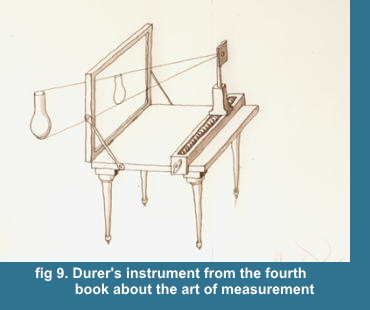
This is an illustration from Durer's fourth book about the art of measurement.
(fig 9) If you really used it, you see it actually nothing for help for
a landscape drawing. However the first impression is good. It will give
you nothing but a very rough outline.
The reasons are below.
First,
the instrument fixs the eye position and picture plain, view frame. So
it doesn't suitable to depict details. It must be a straight-jacket for
a painter.
Secondly,
a is eye position, bc is a picture plain. (fig 10) The instrument fixs
the whole view through the glass of picture plain. But if the eye position
changes from a to a', then the view changes from fg to f'g'. And line af
changes to line a'f' at the point b like a fulcrum of lever.

And the ration l/L is usual big value, then the change is also big. I can't
draw it, if the length of l is much more than 45cm. When L is 45 m, then
the ratio is 45cm/45m=1/100.
So the small position error will be fatal
error. And the instrument naturall fixs the
relative position between each objects. And
its will be changed by the error. For example,
two objects A and B on line aAB will be changed
by the error of eye position a' to line a'AC.
So the instrument has a eye fixer, but you can't endevour to draw for long
work by the intrument. And you won't be able to be satisfied with that
result.
Thirdly,
Even if you could draw the details by all your efforts, you have to trace
the drawing once more on a sheet. Much more draw in details, much more
troubled to trace it. It is really terrible!
I have seen another instruments by perhaps
inventers 18c on a book. But those have same
defect as a Durer's. However those are interesting
as invention, but those are all unpractical
things for a painter use, I think.
And you can see it by a simple experiment
with a plate glass. You can't draw exactly
the details as my drawing.

4-3-05
 bout the fault of the measurement by spherical coordinate
bout the fault of the measurement by spherical coordinate
I have mentioned that my drawing scale bases on the measurement by spherical
coordinates. 4-3-03 (fig 4) But I examined only the difference between
the segment and straigh line between two points.
Actually, the rectangle plain abcd will be
a barrel a'b'c'd' as the shape of the projection
map to the spherical coordinates. This is
a most difficult problem and the fault of
my drawing scale. But it isn't an error but
the problem of a principle. So I examine
here that value.
4-3-06. What kind of figure am I going to l draw and get on a picture plain?
when I measure by my drawing scale a plain HxW with grid.(fig 11)
For an explaining, I illustrated seaparatedly
the curved surface a'b'c'd' and the plain
abcd on fig 11.

H=260mm, W=520mm, h=26mm, w=26mm, oa'=ob'=oc'=od'=600mm
Now I set the curved surface a'b'c'd' and
the plain abcd on the point "o"
of contact.
What I measure as 'w' by my drawing scale is x'ij. So what I get as a line
W on a picture plain by the measuring is the total sum of each x'ij from
the point o'x to o'x.
In the same way, what I get as the plain HxW on a picture plain is the
total sume of each small red square x'ij x y'ij. (fig 11)

If I get the value of xij, then I can get the value x'ij from the former
examination. (4-3-3-04)
The value of xij is changing by the angle
Rij and Sij.
Namely, the triangles( o-o-e and o-o-e' )made by the point "o"
and the grid points on the plain HxW is changing by the Rij an Sij. (fig
12)
The valuee of x'ij and y'ij are given by the equations below.
x'ij=2 x lo x sin(Oxij/2)
Rij=acrtan{cosSj x (w x i-1)/lo}
dxij=lo x cosRij
lj=lo/cosSj
xij/w=lo/(lj/cosRij)=cosRij x cosSj
xij=w x cosRij x cosSj
from the equation(4-3-03-04),
(E=Exij, A=xij, D=dxij, O=Oxij)
Ex1j=x1j/2, Ex2j=x1j+x2j/2, ..., Exij=x1j+x2j+...+x(i-1)j+xij/2,
(x0j=0)
Oxij=arctan{(Exij+xij/2)/dxij}-arctan{(Exij-xij/2)/dxij}
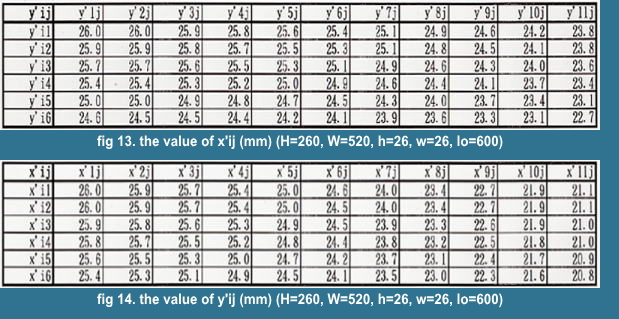
The tables, (fig 13, 14) are the values of x'ij and y'ij.
The conditions are below.
H=260mm, W=520mm, h=26mm, w=26mm, lo=600mm
x'11j and y'i6 aren't needed, but just culculated
for the same table size.
The plotted diagram is shown on the next
The value of x'ij and y'ij are naturally
decreasing according to the distance from
the center.
x'10,6/x'1,1=21.6/26=0.831
y'11,5/y'1,1=23.1/26=0.888
y'ij=2 xlo x sin(Oyij/2)
Sij=arctan{cosRi x(h x j-1)/lo
dyij=lo x cosSij
li=lo/cosRi
yij/h=lo(li/cosSij)=cosSij x cosRi
yij=h x cosSij x cosRi
from the equation(4-3-2-3), (E=Eyij, A=yij,
D=dyij, O=Oyij)
Eyi1=yi1/2, Eyi2=yi1+yi2/2, ..., Eyij=yi1+yi2+...+yi(j-1)+yij/2,
(yi0=0)
Oyij=arctan{(Eyij+yij/2)/dyij}-arctan{(Eyij-yij/2)dyij}
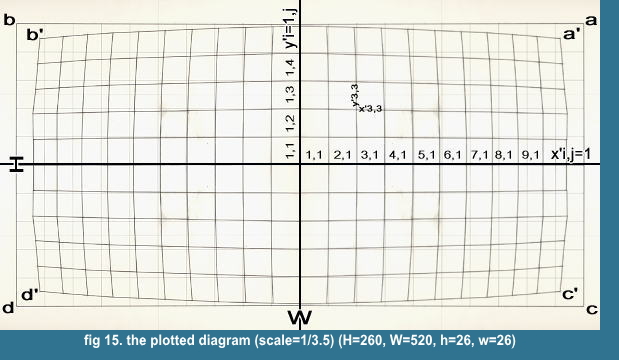
The rectangle plain abcd will be measured
by my drawing scale and drawn as the barrel
shape a'b'c'd'.(fig 15)
Eeach small square is 26x26mm on the plain
abcd.

4-3-07
 photo image and the picture by my drawing scale, what's different?
photo image and the picture by my drawing scale, what's different?
What kind of image do we have on our retina?
I suppose we have the same image by my drawing
scale. Because the retina of our eye is also
a shperical surface. And the image that projected
to the retina through the lens is similar
to the image a'b'c'd', that is a projection
map to the shperical surface.
The problem is that I have to draw the image
on a sheet of paper, a plain. And that image
truely has to be on a shperical surface.
So, I conclude that I can get much more natural
image, if I draw the image on a spherical
surface. But this fantasy isn't practical.
When I see a photo by wide-angle lens, I usually have a sense of incongruity.
Because the peripheral image is strongly effected by the perspective of
wide-angle lens. And the effect gives the impression of unusual, difference
from our eye sight.
But I suppose that this problem is caused by the difference of the relative position between eye and the photo.
If I want to see the photo as that natural image, then I need to set my eye for
the right position to the photo.
The right position what I mean is that a photo by a lens, 90 degree angle
has to be seen at the angle that is made by the points, eye and the both
end points of the photo, will shape the angle as 90 degree.
For example, when the width of that photo is 100mm, then I need to see
it at the distance 50mm from that photo to see it for 90 degree angle.
It is really absurdity! Who does it? We see it usually at the distance 300mm=30cm. So the image by the photo may be not rightly reproduced on our retina.
Because the image projected to the plain,
i.e."w" is always to be kept as
the same ratio,
w=w=w=...=w
but the image on our retina,i.e x'ij is the
projection to the spherical surface to be
changed by the angle Rij. (fig 12)
x'1j>x'2j>x'ij>...>x'10j
For example, even if the Rij is getting closer to 180 degree, "w"
is kept as the same, but x'ij is getting closer to zero. So much more the
angle of the lens becomes wider, then the incongruity about the peripheral
image will be greater, unless we kept the right distance "lo"
between the photo and eye.
Namely, my drawing scale gives much more
natural image than a photo, an image as the
projection map to a plain. Because the image
by my drawing scale present x'ij without
the distance between picture and eye,except the problem of the barrel shape.


uch more exactly explaining, if we saw a photo at the distance between
the photo and an eye much more greater than the right distance "lo",
then we found the sense of unusal about the peripheral image, too big.
Because we are to see the peripheral image for even closer to the value
of "w" which was to be seen for the value of "x'ij"
as the right value. And we usually see a small size of photo, so we see
usually it for much bigger value than the right distance "lo",
as I mentioned. (fig 12)
This is the cause of the impression or sense of incongruity about a photo by wide-angle lens.
On the contrary, the reason why we don't
have the incongruity for the photo by telephoto
lens is that the angle of the lens is smaller
value than that of a wide-angle lens, then
the difference between the value of "w"
and the "x'ij" for both end of
the width is also smaller than the difference
by a wide -angle lens, and the ratio lo/W
becomes bigger than that of the wide-angle
lens.
For example,
the width of the photo, W=100mm,
and the angle of telephoto lens R=10 degree,
then lo=283mm (fig 12)
We usually see the photo probably at that
distance lo=283mmm.
Namely, the incongruity will be happened by the cause of the differece
between the angle of the lens and the angle of our eye position seeing
a photo.
And we will be aware of it easily about a photo by wide-angle lens. Because the differnce between the value of "w" and "x'ij"
become much more bigger according to much more wider the angle of the lens.(fig 12)
And we usually see the photo at the distance much more bigger value than
that of the right distance, especially for the photo by a wide-angle lens.

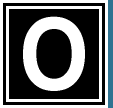
n the contrary to a photo
The picture by my drawing scale will be getting
much more closer to the right ratio between
each "x'ij", if I see the picture
at the distance much more bigger than "lo".
(fig 12)
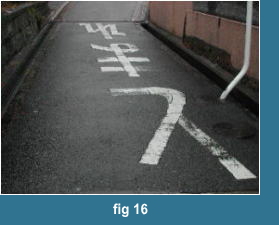
Because the picture by my drawing scale on
paper is the image of the shperical surface
spread on paper, a plain, namely then the
radius "lo=infinte"
So on this case, I see the picture at the
distance less smaller value to the width
of the picture, then I can't get the natural
image, namely the peripheral of the picture
will be seen less smaller than the usual
image.
So my picture gives the natural sight unless
you will be getting too closer to the picture.
Namely, my picture by my drawing scale gives
approximately the right ratio to each "x'ij"
without the eye position, except to stand
too closer.
We aren't usually aware of that fact about photo. Because the nature of
the each part of image from the center image of the photo to the peripheral
is continuingly changing a bit by a bit, so we can't recongnize the value
of the difference by the changing. There is no mark on a photo, nor the
comment about the difference.
But we know that fact well about the letters
on the road. (fig 16)
We know that the letters are written in a long and slender character, that
hight is too taller for the width, but we know it that the letter will
be seen from on a car as the ordinary ratio about the hight and width.
This is the same phenomenon to the peripheral
image of the photo by wide-angle lens.
The hight of character is "w" and
the image hight of letter what we see is
"x'ij" and the ratio of the image
about the hight and width is changing according
to our position, angle "Rij". (fig
12) So we need to stand and see the letters
at the right angle, if we want to see it
for the right image , or the intended image.
These problem is caused by the mixed up the different principles, our sight is
the image projected to a spherical surface but a photo is that to a plain.
So if we want to reproduce the image by the different priciple,
then we need to recognize the condition and nature of the different principle.
This is about only a image, not so serious. I think I may say the analogical problem about our social,
but I think I may not be aware of it for many aspect.

4-3-08
 hy do we feel a straight line as straight
hy do we feel a straight line as straight
By the way, Why do we feel a straight line as straight?
I mean I can't intutively imagin a straight line on a shperical coordinate
system but in a rectangular coordinate system.
Of course, the straight line on a shperical
coordinates means the line on the section
contains a center point of the sphere. But
honestly I feel simply it is curved.
Actually by the closely examination, I see
a long straight structure crosses the eye
field from the right hand end to the left,
for example, the roof of the truck of station,
as curved.
Only two straight lines will be see as straight,
precise the Horizontal line and the vertical
line on center point of the view field. The
others aren't precisely straight.
But our retina is spherical surface, Why
do we feel those twe straight lines on the
spherical surface as straight?
And the other straight lines are equally
curved by the perspective, especially for
the peripheral lines. But only we aren't
usually aware of that. Because we don't have
a definete rectangle border, window that
we can see a view through independantly our
eye as a absolute scale for compareng. The
image of our view field are gradually becoming
ambiguous according to shifting from center
to the peripheral of the retina. So we can't
find the border about our view but the image
is fading away as getting closer to the peripheral.
And we don't usually see the long straight
line crossing our view field from an end
to the other, that we can easily find it
curved, except like looking up at a skyscraoer.
And we can't find a short line being curved,
for the curvature is too small to be recognized
for our sense.
And I think I may say the pschologically,
we often mistake to recognize about our sense.
Our recognition is very rough.
For example, if we see the numbers written on a sheet of paper, like 1,
2, 3, and then there a piece of paper, putting on the sheet, hidding somthing?
and we can see the others like continuingly, like 7, 8, 9, then 10.
Do we apt to suppose the numbers 4, 5, 6 hidden under the piece of paper?
But we won't be able to find the truce until we got rid of the piece.
That is one of our nature for our recognition, I think. I think I may say
about a straight line too. We often see and have learned about the nature
of a straight line and a building built up straight. Then we easily judge
that the vertical line of a building should be seen as a straight vertical
line whether the line is seen on the center of our view field or on the
peripheral, same thing can be said about a horizontal line.
Probably, we don't feel the image of each vertical line on the peripheral
of our view field as declined like the photo by a wide-angle lens. I think
I may conclude, that is it, that we can't recognize the small value of
curvature and we tend to judge a straigh vertical line is straigh and vertical
by the above mentioned reasoning.
On the contrary of that fact of the recognition about the lines parallel
to the true vertical and horizontal line, we are well aware of the nature
of the image of two lines being parallel to each other converging to an
vanishing point along the depth.
The reason is that the value of changing according to the depth is much bigger
than that to the direction of vertical and horizontal. So we can easily find it.
But I need to point out the fact that painters in Eourope can't reproduce a natural image
by the effect of perspective before 15c, exactly saying it, they hadn't recongnized that theoretically and clearly.
Actually, those two parallel lines are never converging
on the one of old Japanese traditional painting style,
YAMATO-E, Yamato-painting, the parallel lines is always parallel,
and the image is expressed by the angled top view and the square floor plain is expressed as a parallelogram.
Precisely measuring and drawing by my drawing
scale, the lines being parallel to the vertical
and horizontal lines except the two center
lines are gradually increasing the value
of curvature according to the distance from
the center.
But, probably we don't aware of that, except
like a sensation about the convergent of skyscraper
in near.

4-3-09
 asic rule about a vertical and a horizontal line and a straight line
asic rule about a vertical and a horizontal line and a straight line
So practically, I used to draw a line parallel to a vertical and horizontal line as a straight vertical
and horizontal line, unless I could measure clearly the different value about the perspective effect.
A straight line parallel to a center vertical line is vertical and straight
in everywhere, a straight line parallel to a center horizontal line is
also horizontal and straight and a straight line is straight in everywhere,
very generously manner or roughly or bravely, like a Einstein declared "
the velocity of light is constant in every space" or like a President Bush "a terrorist is terrorist"
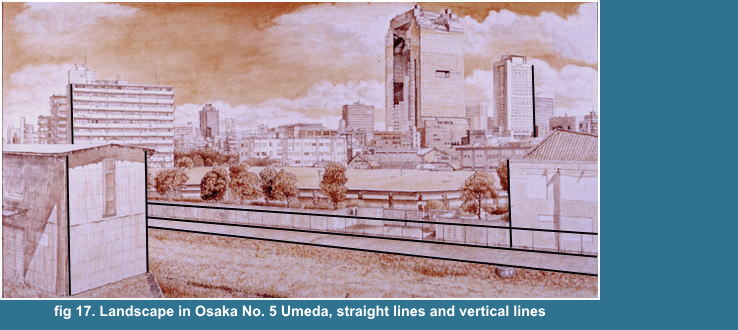
For, if I took the difference of principles too much seriously, I can't draw only a line by the different prinples between measuring by the spherical cordinates and drawing on a plain, I'm not a physicist, nor a critic, but a painter, though, indeed I name only by myself. You will find afterward that I only measure the minimum points that I need for drawing. This technique is no more than just a tool. The essence of my wartercolor is never based on that mere technique. If you can't draw by freehand, then you can never exactly draw even though you used my drawing scale or much more high-tech measuring tool and PC. Because this is a picture, never a photo, nor computer graphic.
If you want to know what is a picture, you
need to study and look many arts and observe
the nature and think. You did it, then you
knew it.
But the process, or the basic rule might
be better to change case by case for a practical
handling.
Surely, it might be better to measure and draw precisely two parallel straight
lines across the view field an end to the oher as a precise curved lines,
according to the values.
For example, as I mention about the fence and the road along the fence
across from the right hand end to the left of Landscape in Osaka No. 5
Umeda, I had generously drawn those as two straight lines slightly converging
each other along the left direction on the watercolor, truely those two
lines should be slightly curved, so that happened to make me aware of the
effect of the barrel shape. (fig 17) I tried again and again to measure
the same object, but the relative position of each object on the centeral
part of the picture didn't accord with others, though the values of measuring
were same.
Then I had to be aware of it, that the values of measurement are right, but I couldn't build up and draw rightly the image.
Why?
conclusion 2.
4-3-05 The whole image measured by my drawing scale is built up as a barrel shape.(fig 15)
You need to remember the conclusion 2, becasue
you are going to often deal with that effect
to build up naturally your image. The conclusion
1 is also important but you can do it, even
though you had forgotten it.


 Preface
Preface


 3-1. Why do I use a 0.3mm mechanical pencil and pen?
3-1. Why do I use a 0.3mm mechanical pencil and pen? hy am I going to draw exactly?
hy am I going to draw exactly? hat is the individuality of a realism painting
hat is the individuality of a realism painting painter is usually painting not knowing his What?, How?, Why? to his painting.
painter is usually painting not knowing his What?, How?, Why? to his painting. e won't say that we painted the individual picture, only we painted
a different picture.
e won't say that we painted the individual picture, only we painted
a different picture. e can neither paint the view as it is, nor arrived at the only
one expression, the Objective itself, if we tried to do it.
e can neither paint the view as it is, nor arrived at the only
one expression, the Objective itself, if we tried to do it. xamples about the Objective and the Subjective, the result is various
for the condition, where we stress on between them.
xamples about the Objective and the Subjective, the result is various
for the condition, where we stress on between them. he extent branching;
he extent branching; ut, whatever the contemporary atists choose for media, generally their
expression haven't enough contents. For, as I mentioned, their object have
been purified.
ut, whatever the contemporary atists choose for media, generally their
expression haven't enough contents. For, as I mentioned, their object have
been purified. amely, our expression is too ambious to that concept
amely, our expression is too ambious to that concept here it is what I understand as beauty?
here it is what I understand as beauty? didn't feel that house like this, but saw that house like this.
But, that is still the judgement by our sensation through our eyes means,
as a result, that I paint it as I felt it, even I painted it faithfully
to the view.
didn't feel that house like this, but saw that house like this.
But, that is still the judgement by our sensation through our eyes means,
as a result, that I paint it as I felt it, even I painted it faithfully
to the view. e can stress on the particular object in the view, and the stressed
painting can be much more natural to our sensation, for we have some particular
tendancies about the judgement of eyesight, and also we often project our
feelings and emotions to the view, and recall that feelings and emotions
in our experience by the view as well.
e can stress on the particular object in the view, and the stressed
painting can be much more natural to our sensation, for we have some particular
tendancies about the judgement of eyesight, and also we often project our
feelings and emotions to the view, and recall that feelings and emotions
in our experience by the view as well. e apt to project our feeling and emotion to our view, so that Being
Subjective can be also the object of our painting. But those are psychological
problems. And I think it nonsense to guess the Being Subjective has independently
particular expression.
e apt to project our feeling and emotion to our view, so that Being
Subjective can be also the object of our painting. But those are psychological
problems. And I think it nonsense to guess the Being Subjective has independently
particular expression. e may sucessfully reproduce that feelings and emotions by preparing that envoirnments, even though it were constituted by only the visual images for one sansation, eyesight.
e may sucessfully reproduce that feelings and emotions by preparing that envoirnments, even though it were constituted by only the visual images for one sansation, eyesight. eally, those are the best examples of the indifference between the saying
and the behaving, that are connected at random.
eally, those are the best examples of the indifference between the saying
and the behaving, that are connected at random. hat might be defined by the logos is the simple meaning, not the double, or multiple meanings
(except literature's expression), but what might be expressed by the visual element can contain the complex meanings, much more precisely
say it, the many informations.
hat might be defined by the logos is the simple meaning, not the double, or multiple meanings
(except literature's expression), but what might be expressed by the visual element can contain the complex meanings, much more precisely
say it, the many informations. hat composition do I love for landscape?
hat composition do I love for landscape? need a middle view to settle the impression or atomsphere of the city
or town in painting. And distant view has the role to support to settle
the idea the expansion of the city.
need a middle view to settle the impression or atomsphere of the city
or town in painting. And distant view has the role to support to settle
the idea the expansion of the city. bout the sheet size.
bout the sheet size.
 bout the method of landscape drawing
bout the method of landscape drawing wo drawing methods
wo drawing methods What is the size of the image?
What is the size of the image? We have the visual field as the function of eyes more than 180 degree.
But you can't see clearly the both end of the sides. We can see only vaguley
these sides. As I said, we have the central visual field about 30 degree
for clear vision. If you look at one object very carefully, then you won't
be able to recognize the surroundings.
We have the visual field as the function of eyes more than 180 degree.
But you can't see clearly the both end of the sides. We can see only vaguley
these sides. As I said, we have the central visual field about 30 degree
for clear vision. If you look at one object very carefully, then you won't
be able to recognize the surroundings. bout the setting of the paper board and an easel
bout the setting of the paper board and an easel he method by my drawing scale
he method by my drawing scale This is very simple tool, but much more practical for a painter than any
other devices for perspective, like what Durer had mentioned about or instruments
has links or prism by inventors perhaps 18c.
This is very simple tool, but much more practical for a painter than any
other devices for perspective, like what Durer had mentioned about or instruments
has links or prism by inventors perhaps 18c. he characteristics of my drawing scale
he characteristics of my drawing scale So it needs not the exact sketching position, i.e. eye position.
Because the important relative position, distant between eye and measuring position are naturally fixed by my drawing scale. (fig 3)
So it needs not the exact sketching position, i.e. eye position.
Because the important relative position, distant between eye and measuring position are naturally fixed by my drawing scale. (fig 3) 4-3-03-02 parallax error
4-3-03-02 parallax error hen the eye positon happen to change from at a to a', then
the measured value of the object length A will be A', how much is the minimum error?
hen the eye positon happen to change from at a to a', then
the measured value of the object length A will be A', how much is the minimum error? for the object faced at right angle A/2>E
(fig 5)
for the object faced at right angle A/2>E
(fig 5) 4-3-03-04. for the object faced at right angle A/2<E (fig 6)
4-3-03-04. for the object faced at right angle A/2<E (fig 6) error bd'=(A'-A)xA/A
error bd'=(A'-A)xA/A or the object diagonally faced
or the object diagonally faced Now, Let see the error for the diagonal object
A.
Now, Let see the error for the diagonal object
A. B=300 cm
B=300 cm bout another instrument for drawing
bout another instrument for drawing This is an illustration from Durer's fourth book about the art of measurement.
(fig 9) If you really used it, you see it actually nothing for help for
a landscape drawing. However the first impression is good. It will give
you nothing but a very rough outline.
This is an illustration from Durer's fourth book about the art of measurement.
(fig 9) If you really used it, you see it actually nothing for help for
a landscape drawing. However the first impression is good. It will give
you nothing but a very rough outline. And the ration l/L is usual big value, then the change is also big. I can't
draw it, if the length of l is much more than 45cm. When L is 45 m, then
the ratio is 45cm/45m=1/100.
And the ration l/L is usual big value, then the change is also big. I can't
draw it, if the length of l is much more than 45cm. When L is 45 m, then
the ratio is 45cm/45m=1/100. bout the fault of the measurement by spherical coordinate
bout the fault of the measurement by spherical coordinate H=260mm, W=520mm, h=26mm, w=26mm, oa'=ob'=oc'=od'=600mm
H=260mm, W=520mm, h=26mm, w=26mm, oa'=ob'=oc'=od'=600mm


 photo image and the picture by my drawing scale, what's different?
photo image and the picture by my drawing scale, what's different? uch more exactly explaining, if we saw a photo at the distance between
the photo and an eye much more greater than the right distance "lo",
then we found the sense of unusal about the peripheral image, too big.
uch more exactly explaining, if we saw a photo at the distance between
the photo and an eye much more greater than the right distance "lo",
then we found the sense of unusal about the peripheral image, too big. n the contrary to a photo
n the contrary to a photo Because the picture by my drawing scale on
paper is the image of the shperical surface
spread on paper, a plain, namely then the
radius "lo=infinte"
Because the picture by my drawing scale on
paper is the image of the shperical surface
spread on paper, a plain, namely then the
radius "lo=infinte" hy do we feel a straight line as straight
hy do we feel a straight line as straight asic rule about a vertical and a horizontal line and a straight line
asic rule about a vertical and a horizontal line and a straight line
